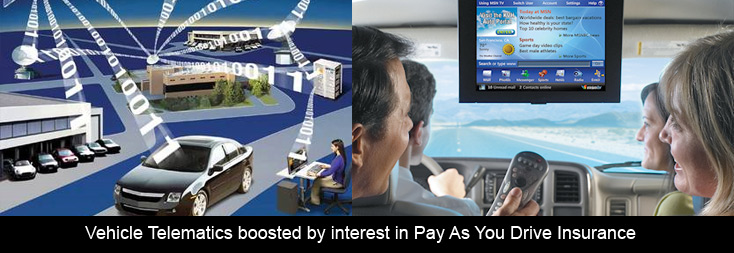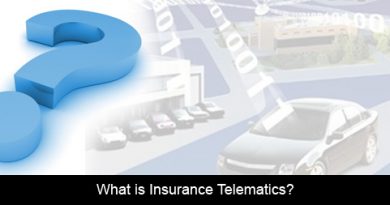Vehicle Telematics boosted by interest in Pay As You Drive Car Insurance
There has been an increased interest across the globe in the benefits of usage based car insurance. This system of vehicle insurance, also known as Pay As You Drive enables vehicle owners to pay reduced car insurance premiums based only on the distances that they drive and the way that they drive! It is however not only the car insurance industry and those with PAYD options that could be expected to benefit – but also the suppliers of fleet management technology!
Fleet Management Technology and Driving Behaviour
Telematics can be defined as the technology of sending, receiving and storing information via telecommunication devices in conjunction with effecting control on remote objects. Telematic usage based insurance requires that vehicle information is automatically transmitted to the tracking system. This provides a much more immediate feedback loop to the driver, by changing the cost of insurance dynamically with a change of risk, and this means drivers have a stronger incentive to adopt safer practices.
Fleet management technology and telematics help fleets save costs on fuel, vehicle maintenance and insurance and allows them to pay only for the distances covered. It allows operators to monitor driving behaviour scientifically, enabling fleet owners to decide at an earlier stage which drivers might pose a higher risk. Fleet owners can now predict those drivers who were most likely to have an accident and have data to prove if any of the drivers are exceeding speed limits.
What is Pay As You Drive / Usage Based Car Insurance?
I would like to refer briefly to the description found at Wikipedia:
“Usage based insurance, also known as pay as you drive (or PAYD) is a type of automobile insurance whereby the costs of motor insurance are dependent upon type of vehicle used, measured against Time, Distance and Place.
This differs from traditional insurance, which attempts to differentiate and reward “safe” drivers, giving them lower premiums and/or a no-claims bonus.”
The basics of usage based car insurance
We would like to quote briefly a nice summary on Wikipedia about the types of usage based car insurance:
The simplest form of usage based insurance bases the insurance costs simply on the number of miles driven. However, the general concept of Pay As You Drive includes any scheme where the insurance costs may depend not just on how much you drive but how, where and when you drive.
Pay as you drive (PAYD) means that the insurance premium is calculated dynamically, typically according to the amount you drive.
3 Types of usage based insurance
1. Coverage is based on the odometer reading of the vehicle.
2. Coverage is based on the number of minutes the vehicle is being used as recorded by a vehicle-independent module transmitting data via cellphone or RF technology.
3. Coverage is based on other data collected from the vehicle, including speed and time-of-day information in addition to distance or time travelled. Other data could include where you are driving and driving behaviour such as speeding, excessive braking etc.
The formula can be a simple function of the number of miles you drive, or can vary according to the type of driving or the identity of the driver. Once the basic scheme is in place, it is possible to add further details, such as an extra risk premium if someone drives too long without a break, uses their mobile phone while driving, or travels at an excessive speed.
Growing interest in Pay As You Drive Car Insurance
Interest in the pay-as-you drive (PAYD) concept is growing worldwide. More insurance companies are developing PAYD products and more states and cities are looking into the benefits of encouraging people to drive less in an effort to reduce congestion and hence pollution.
We would like to refer briefly to some recent international trends and signs of an increased acceptance of Pay As You Drive:
* Expansion of Interest: New York City is soliciting information from interested parties about PAYD programs that could be implemented in New York State and the City in the hope of reducing congestion and hence pollution. Specifically, it wants to know whether there are legal, regulatory, financial or technical issues that would pose a barrier to implementation; what would have to be done to make such a program successful; and the role that government can play in the development of a market for PAYD products, among other things. For insurers, the cost of implementing a PAYD system poses the greatest barrier to developing one.
* Massachusetts has also expressed an interest in PAYD. The state plans to reduce greenhouse gas emissions to 25 percent below 1990 levels over the next decade. Since more than one third of emissions in the state can be attributed to the transportation sector, the state plans to start a pilot PAYD program.
* Existing Programs: The California Insurance Department adopted a PAYD regulation in 2009. The filings of two auto insurers, State Farm and the Auto Club of Southern California, to offer PAYD programs were approved in 2010. State Farm estimates that ultra-low-mileage drivers, those who drive less than 2,000 miles a year, could save as much as 45 percent of the cost of a traditional six-month policy.
* The California PAYD regulation allows an insurer to offer a program that bases the miles-driven rating factor for auto insurance on miles driven and verified rather than on estimated mileage. Under the California PAYD program, the policyholder agrees in advance to have the miles driven verified at the end of the policy period, and the premium adjusted retroactively if justified under the terms of the policy. Insurers may also offer policyholders the option to purchase auto insurance coverage for a specified price per mile.
* The California program is optional for both insurers, which may elect not to offer a PAYD policy, and for policyholders, who may continue to purchase a traditional auto insurance policy. Under California’s auto insurance law, the number of miles driven annually is the second most important factor in setting auto insurance rates—the policyholder’s driving record is the first. A 2006 California Insurance Department study found that 56 percent of policyholders underreported mileage. Insurers generally favor the PAYD concept. To encourage participation in the program by people who are concerned about privacy, the California PAYD regulations specifically prohibit insurers from requiring the use of a device that collects information on the vehicle’s location.
* In Washington State, where a five-year state wide pilot program is in its third year, insurers urged lawmakers to enact legislation that would protect the models and technology used in PAYD programs as proprietary information. Legislators had considered a bill that would have accomplished this, but it eventually failed to pass. One insurer with both mileage and usage-based products testified that it had spent millions of dollars developing the programs and wanted its research and development to be protected from competing insurers.
* In Texas, where a mileage-based law was passed in 2001, one insurer is offering auto insurance by the mile directly to consumers online. Policies are valid for the amount of miles purchased, from 1,000 to 6,000 miles, or a six-month period, whichever occurs first, and premiums are calculated based on the vehicle driven, its location and the age of the driver.
* Allstate has launched a PAYD program in Illinois and has plans to expand to others states in 2011.
Conclusion
Manufacturers of vehicle telematics could expect an increased demand for technology developed with Pay As You Drive and Usage Based Insurance in mind. As this technology becomes more advanced and affordable it could help motorists put the brakes on rising car insurance premiums and incentivise them with a constant reminder to focus on safer driving behaviour!!
We would like to invite readers to also view:
Pay As You Drive and Car Insurance




